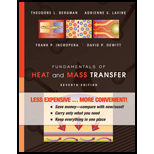
Concept explainers
Show that, for water at 1-atm pressure with
The physical significance of Jakob number for water and verify if this conclusion applies to other fluids and to show that Jakob number is unity for water.
Answer to Problem 10.1P
The Jakob number is less than unity for water and this applies to all the fluids which signify that Jakob number is always to be much less than unity.
Explanation of Solution
Given:
Pressure of water is
The temperature difference
Concept used:
Refer to table A-6 “Thermo physical properties of saturated water at pressure of 1.0133 bar” to obtain the value of heat of vaporization as
Write the expression for Jakob number of water.
Here,
Calculation:
Substitute
The value of Jakob number is
As the Jakob number is very less for water, it implies that the vapors absorbing latent heat is more than the vapors absorbing the sensible heat during the boiling phase change.
Check the value of Jakob number for other fluids like Ethylene glycol and mercury.
Refer to table A-5 “Thermo physical properties of saturated fluids at pressure of 1 atm” to obtain the value of heat of vaporization for ethylene glycol as
Substitute
Thus, the value of Jakob number for ethyl glycol is also than unity.
Refer to table A-5 “Thermo physical properties of saturated fluids at pressure of 1 atm” to obtain the value of heat of vaporization for mercury as
Substitute
Thus, the value of Jakob number for mercury is also than unity.
Conclusion:
Thus, the Jakob number is less than unity for water and this applies to all the fluids which signify that Jakob number is always to be much less than unity.
Want to see more full solutions like this?
Chapter 10 Solutions
Fundamentals of Heat and Mass Transfer
Additional Engineering Textbook Solutions
INTERNATIONAL EDITION---Engineering Mechanics: Statics, 14th edition (SI unit)
Mechanics of Materials (10th Edition)
Web Development and Design Foundations with HTML5 (8th Edition)
Degarmo's Materials And Processes In Manufacturing
Thinking Like an Engineer: An Active Learning Approach (4th Edition)
Starting Out with Programming Logic and Design (5th Edition) (What's New in Computer Science)
- An Inclining experiment done on a ship thats 6500 t, a mass of 30t was moved 6.0 m transvesly causing a 30 cm deflection in a 6m pendulum, calculate the transverse meta centre height.arrow_forwarda ship 150 m long and 20.5 m beam floats at a draught of8 m and displaces 19 500 tonne. The TPC is 26.5 and midshipsection area coefficient 0.94. Calculate the block, prismatic andwaterplane area coefficients.arrow_forwardA vessel loads 680 t fuel between forward and aft deep tanks. centre of gravity of forward tank is 24m forward of ships COG. centre to centre between tanks is 42 m. how much in each tank to keep trim the samearrow_forward
- Beam of a vessel is 11% its length. Cw =0.72. When floating in SW of relative denisity 1.03, TPC is 0.35t greater than in freshwater. Find the length of the shiparrow_forwardAn inclining experiment was carried out on a ship of 4000tonne displacement, when masses of 6 tonne were moved transverselythrough 13.5 m. The deflections of a 7.5 m pendulurnwere 81, 78, 85, 83, 79, 82, 84 and 80 mm respectively.Caiculate the metacentric height.arrow_forwardA ship of 10 000 tonne displacement has a waterplanearea of 1300 m2. The ship loads in water of 1.010 t/m3 andmoves into water of 1.026 t/m3. Find the change in meandraughtarrow_forward
- A ship of 7000 tonne displacement has a waterplane areaof 1500 m2. In passing from sea water into river water of1005 kg/m3 there is an increase in draught of 10 cm. Find the Idensity of the sea water.arrow_forwardA ship has 300 tonne of cargo in the hold, 24 m forward ofmidships. The displacement of the vessel is 6000 tonne and its centre of gravity is 1.2 m forward of midships.Find the new position of the centre of gravity if this cargo ismoved to an after hold, 40 m from midshipsarrow_forwardSketch and describe how ships are supported in dry dock. When and where does the greatest amount of stresses occur?arrow_forward
- Sketch and desribe a balanced rudder and how it is suspendedarrow_forwardA ship 140 m long and 18 m beam floats at a draught of9 m. The immersed cross-sectionai areas at equai intervais are 5,60, 116, 145, 152, 153, 153, 151, 142, 85 and 0 m2 respectively.Calculate:(a) displacement(b) block coefficient(c) midship section area coefficient(d) prismatic coefficient.arrow_forwardA steamer has waterplane area 1680m2 recorded in water with relative denisty 1.013. Displacement = 1200 t, calculate difference in draught in salwater reltive denisity 1.025.arrow_forward
 Principles of Heat Transfer (Activate Learning wi...Mechanical EngineeringISBN:9781305387102Author:Kreith, Frank; Manglik, Raj M.Publisher:Cengage Learning
Principles of Heat Transfer (Activate Learning wi...Mechanical EngineeringISBN:9781305387102Author:Kreith, Frank; Manglik, Raj M.Publisher:Cengage Learning Refrigeration and Air Conditioning Technology (Mi...Mechanical EngineeringISBN:9781305578296Author:John Tomczyk, Eugene Silberstein, Bill Whitman, Bill JohnsonPublisher:Cengage Learning
Refrigeration and Air Conditioning Technology (Mi...Mechanical EngineeringISBN:9781305578296Author:John Tomczyk, Eugene Silberstein, Bill Whitman, Bill JohnsonPublisher:Cengage Learning

